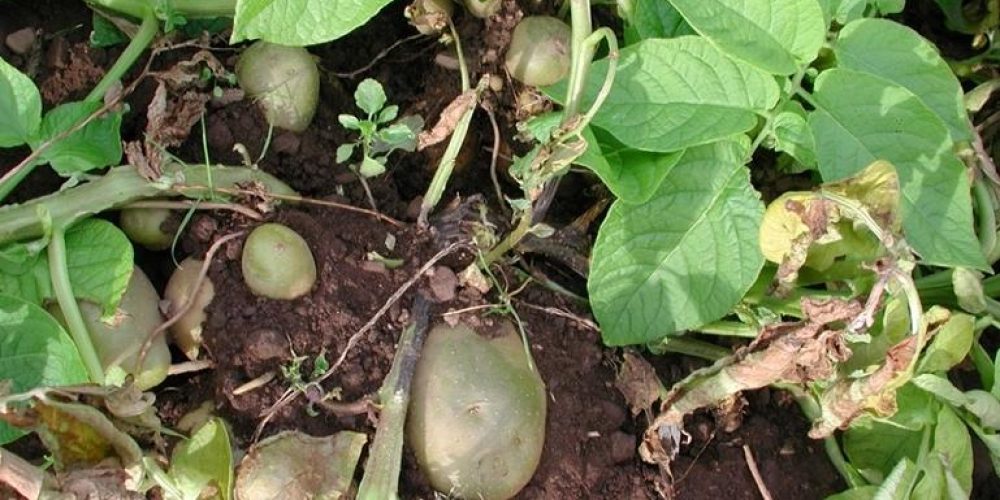Table of contents of the article
Toggle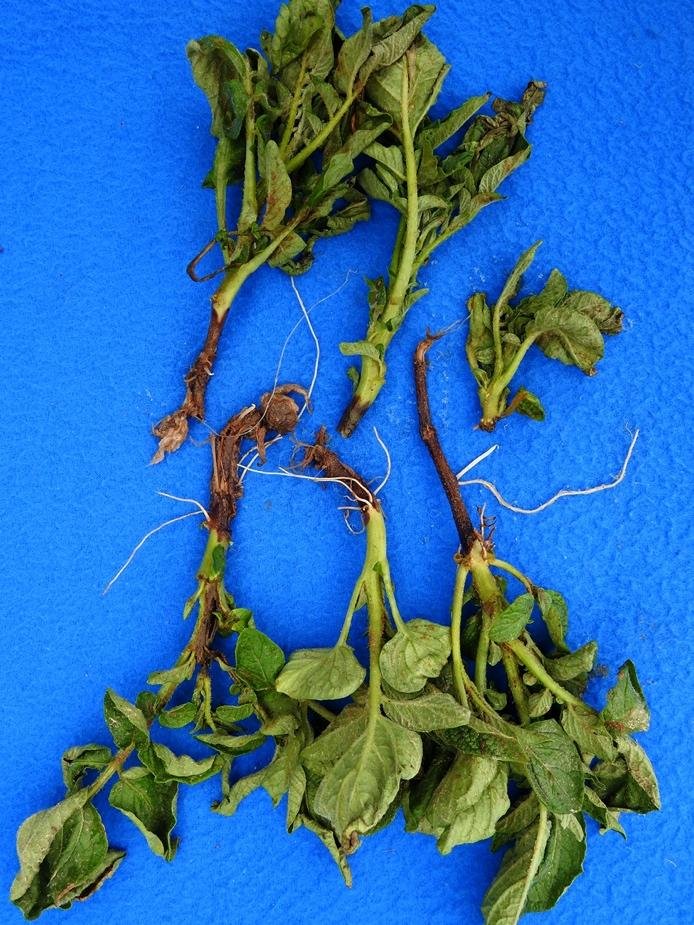
Blackleg disease is a bacterial disease that affects potato stalks, leading to the plant weakening and wilting. This article from the “WORLD OF PLANTS” website discusses how to prevent and effectively control blackleg disease on potato stems.
Introduction to black leg disease on potato stems
- Name of the disease: Black leg disease on potatoes
- Scientific name: Pectobacterium atrosepticum and Pectobacterium parmentieri
- Type of disease: Bacterial pathogen
- The family: Pectobacteriaceae
Potato (Solanum tuberosum) is a globally vital crop, yet its production is constantly threatened by various diseases. One of these big threats is blackleg disease, which is caused by bacterial organisms such as Pectobacterium atrosepticum and Pectobacterium parmentieri.
This article aims to explore the life cycle of the bacterial pathogen, symptoms, etiology, preferred conditions, and effective control strategies for blackleg disease, providing comprehensive insights to enable farmers to achieve optimal management.
Life cycle of blackleg disease on potato stalks
Understanding the life cycle of the bacterial organisms causing blackleg disease is crucial for developing effective management strategies. These bacteria usually penetrate the plant through wounds, cut surfaces, or natural openings. Once inside the plant, they multiply rapidly, leading to tissue decomposition and the appearance of characteristic symptoms. Infected plants and tubers serve as potential sources of bacteria, promoting the disease cycle.
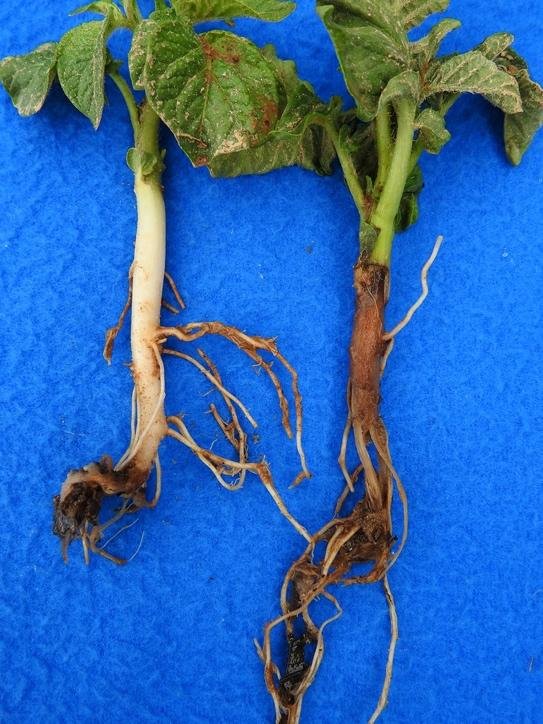
Symptoms of black leg disease on potato stalks
- Early symptoms: Early signs of blackleg include mild wilting and yellowing of the lower leaves, which may easily be mistaken for other conditions, making early detection difficult.
- Late symptoms: As the disease progresses, the wilt intensifies, and the lower stem becomes darker, giving the disease its name. Affected stems become soft and limp, eventually causing the plant to collapse.
- Characteristic symptoms: One of the characteristic symptoms of blackleg disease is the presence of black necrotic lesions on the lower leg, extending upward from the ground line. Infected stems can easily be broken at the point of infection, distinguishing blackleg disease from other potato diseases.

Favorite conditions for blackleg disease on potato stalks
Blackleg disease bacteria show a preference for specific environmental conditions that contribute to their development and disease onset. Understanding these favorable conditions is critical to implementing effective preventative measures.
- Temperature and humidity: Blackleg disease bacteria thrive in pleasant temperatures between 15-25°C and high humidity conditions. Early spring and late fall provide favorable conditions for the development of the disease. Monitoring the situation environmentally and taking preventive measures is vital during these cooler periods when the pathogen shows increased activity.
- Humidity management: Excess moisture, whether from rain or irrigation, creates an environment conducive to the spread of blackleg disease. Good soil drainage and good aeration are essential to reduce the risk of developing the disease. Adequate spacing between plants in the field contributes to reducing humidity around the plants.
- Environment Preferences: Blackleg disease bacteria prefer open field conditions over green houses. The natural circulation of air in open fields, combined with lower temperatures, lends itself to environmental conditions that promote bacterial growth. Greenhouses, with their controlled environments and higher temperatures, are less conducive to the development of blackleg disease.
Understanding and managing these favorable conditions is vital for developing a proactive strategy against blackleg disease in potato crops. By taking measures to mitigate these factors, farmers can significantly reduce the susceptibility of potato crops to blackleg disease.
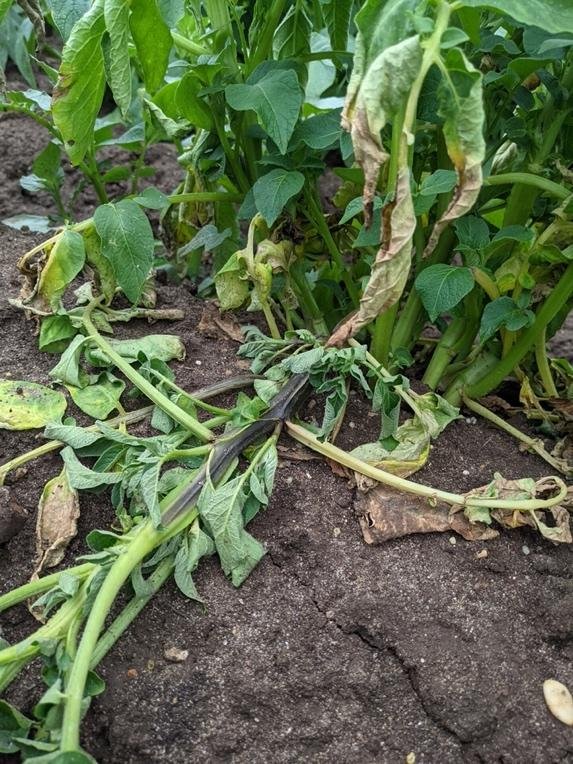
Causes of black leg disease on potato stalks
Several factors contribute to the resurgence of blackleg as a prominent potato pathogen. Contaminated water, equipment, and infected potato tubers play roles in the introduction and spread of bacteria. Favorable conditions during the planting and harvesting processes, such as cool weather and humidity, create ideal environments for bacteria to grow and develop disease.
Losses from blackleg disease on potato stalks
Blackleg disease poses a major threat to potato crops, resulting in huge economic losses. The disease can rapidly decompose the stems and tubers, making them unfit for consumption or processing. The bacteria causing blackleg can also lead to secondary infection, further impacting crop quality and production.
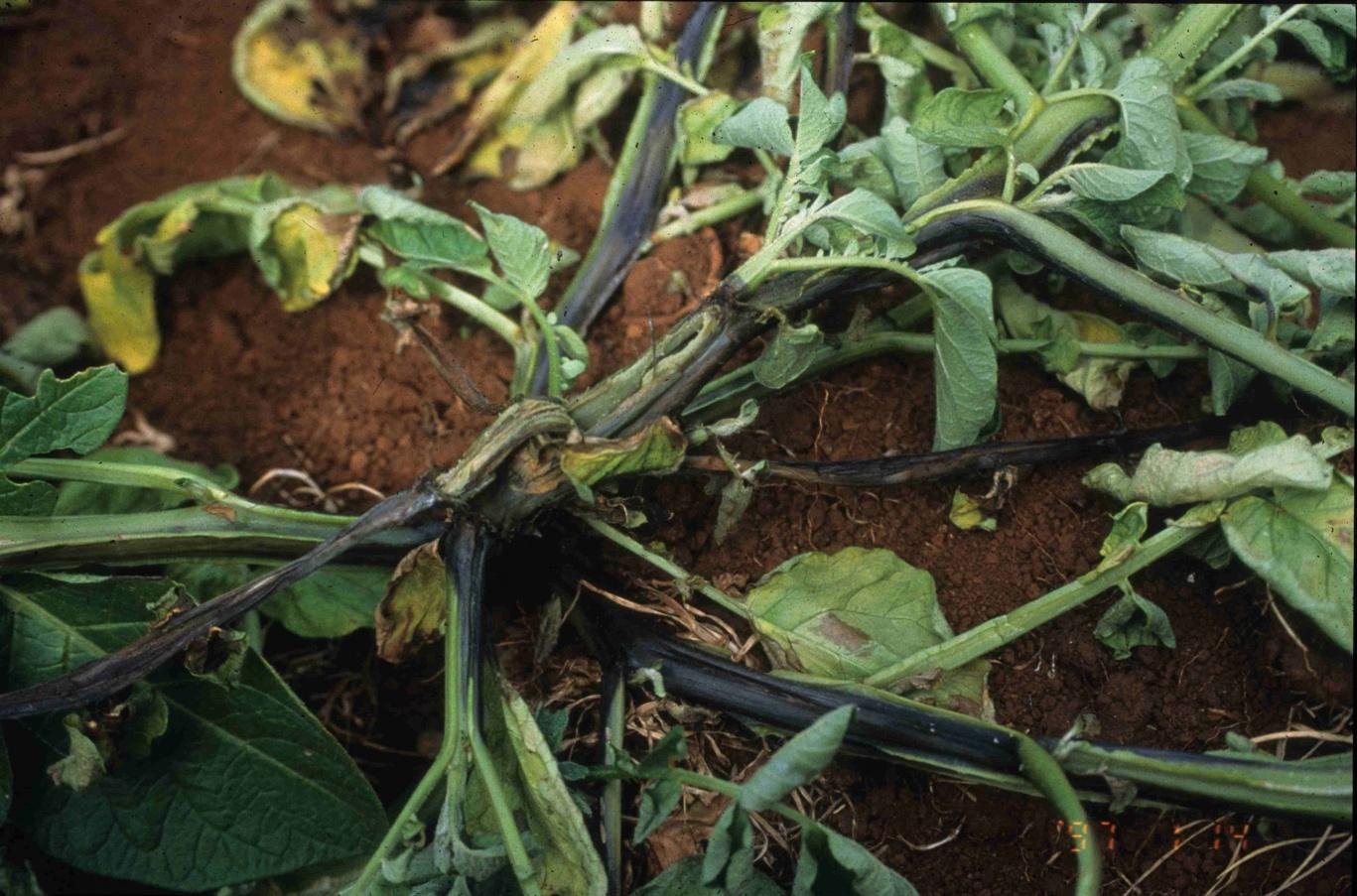
Control strategy for blackleg disease on potato stems
Effective management of blackleg disease requires a comprehensive strategy, integrating agricultural, chemical and organic practices.
- Agricultural practices: Proper agricultural practices, including crop rotation, proper spacing, and timely harvest, are crucial to reducing the risk of blackleg disease. Removing infected plant material after harvest is key to reducing the chances of survival through the winter.
- Chemical control: Copper-based fungicides, such as copper hydroxide and copper sulphate, can be effective against the bacteria that cause blackleg. Antibacterial compounds such as streptomycin may also play a role in fighting the disease. Adherence to recommended application rates is vital to maximize efficiency.
- Organic control: Organic fungicides containing beneficial microorganisms, such as Bacillus and others, and plant extracts such as neem oil, can be incorporated into an organic blackleg disease management plan. The balance between preventive measures and biological treatments contributes to an effective and environmentally friendly strategy for disease control.
Preventive measures for blackleg disease on potato stalks
Effective prevention is the way to reduce the risk of blackleg disease spreading in potato crops. Implementing a comprehensive set of preventive measures is vital to enhance the resilience of potato crops and protect them from the devastating impact of blackleg disease.
- Choosing disease-resistant varieties: Start by selecting disease-resistant potato varieties as a strong line of defense against blackleg disease pathogens.
- Improving soil drainage: Promote proper soil drainage to reduce the development and spread of blackleg disease. Proper plant spacing and well-drained soil help reduce conditions conducive to bacterial infections, especially when temperatures reach above 10 degrees.
- Monitor the field regularly: Perform careful field checks on a regular basis to identify plants showing symptoms of blackleg disease and remove them quickly. Early detection is crucial to containing the spread of the disease.
- Rotation with non-host crops: Break the disease cycle by practicing rotation with non-host crops. Transmission to non-host crops for two to three years reduces the availability of suitable hosts for blackleg disease pathogens.
- Eliminate the host plants of the disease: Eliminate any potential hosts in the vicinity of the field, reducing the risk of blackleg disease returning. Removing host plants too quickly disrupts the fungal organism cycle.
- Balanced fertilization practices: Avoid excessive nitrogen fertilization, as this can create favorable conditions for the development of blackleg disease. Adopt recommended fertilization practices to promote healthy plant growth without compromising resistance.
- Use of plant stimulants: Incorporate plant stimulants or natural resistance stimulants to enhance potato plants' natural defenses against blackleg disease. These substances can include growth stimulants or plant extracts with antimicrobial properties.
- Responsible disposal of plant residues: Responsibly dispose of harvested potato tubers and plant debris by burying them at least 2 feet deep or using them as animal food. This helps eliminate potential establishment sites for blackleg pathogens.
- Avoid growing potatoes in cold conditions: It is recommended to avoid growing potatoes in extremely cold conditions. Planting during cooler seasons, such as early spring or late fall, may create a more hospitable environment for blackleg disease bacteria. Choosing warmer growing conditions helps mitigate the impact of the disease.
- Planting the whole tuber, not part of it: When planting potatoes, you should use the entire tuber rather than planting cut pieces. Blackleg disease bacteria often gain access to the plant through wounds or cut surfaces. Growing whole tubers reduces the risk of introducing the fungal organism through the cut surfaces, reducing potential entry points for bacteria.
Adherence to these preventive measures collectively contributes to building a strong defense against blackleg disease, ensuring the health and productivity of potato crops throughout their growth cycle. Vigilance, combined with these anticipatory actions, is the key to reducing the impact of this persistent and devastating bacterial disease.
Conclusion
In conclusion, the blackleg disease threat to potato production requires consistent attention and effective management. Pectobacterium atrosepticum and Pectobacterium parmentieri require a comprehensive approach for sustainable control. The ideas shared in this article highlight the importance of caution, early detection and integrated control.
The potential for blackleg disease to cause significant losses is a reality that farmers must face. Therefore, collaboration between researchers, farmers and decision-makers becomes essential to deal with emerging challenges and secure the future of sustainable potato production. By implementing the preventative measures described here, potato growers can strengthen their defenses against this devastating bacterial disease.
As times move forward, staying informed, adopting innovative strategies, and strengthening collective commitment to agricultural resilience will be vital. Blackleg disease may persist, but with shared knowledge and collaborative efforts, we can grow potato crops that thrive, ensuring food security and economic well-being for farming communities.
We would like to point out that we, on the World of Plants website, provide you with all the services you need in the world of plants. We provide all farmers and those interested in plants with three main services: -
- Artificial intelligence consulting service to help you identify diseases that affect plants and how to deal with them.
- Blog about plants, plant diseases and care of various crops ... You are currently browsing one of her articles right now.
- An application that provides agricultural consultations to clients, as well as a service for imaging diseases and knowing their treatment for free – Click to download the Android version from Google Play Store، Click to download the IOS version from the Apple App Store.
Resources:
- Charkowski, A. O. (2018). The Soft Root Erwinia. Reference Module in Life Sciences.
- Pérombelon, M. C. M. (2002). Potato diseases caused by soft rot erwinias: an overview of pathogenesis. Plant Pathology, 51(1), 1-12.
- Toth, I. K., van der Wolf, J. M., Saddler, G., Lojkowska, E., & Hélias, V. (2011). Chapter Four - Soft Rot Erwiniae: from genes to genomes. Advances in Applied Microbiology, 76, 1-25.
- De Boer, S. H., Li, X., & Ward, L. J. (2012). Pectobacterium spp. Associated with bacterial stem rot syndrome of potatoes in Canada. Phytopathology, 102(10), 937-947.
- Plantix – Blackleg of Potato
- Agrio – Growing Potatoes: A Step-by-Step Guide to Potato Sprouts Planting




